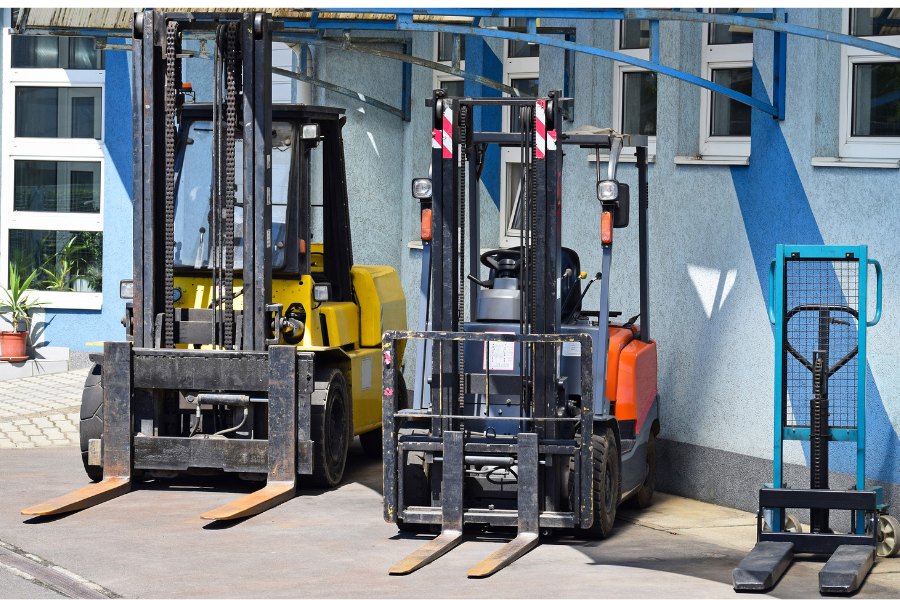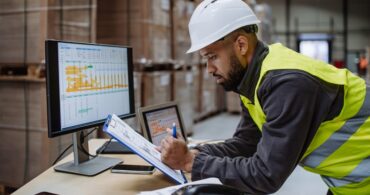Forklifts come in all shapes and sizes. There are mammoth beasts that roam construction sites and petite workhorses that navigate narrow aisles. To bring order to these vast and varied machines, OSHA created seven classes of forklifts.
The term “forklift classes” may conjure thoughts of autumn months, heavy backpacks, and studying for tests. However, this article isn’t focused on a forklift academy. This is a look at how the Occupational Safety and Health Administration (OSHA) categorizes powered industrial trucks (machines we humans know as “forklifts”). Each classification is defined by the design of the machine, the environment where it is used and the tasks it performs.
Class 1: Electric motor rider trucks
To call a forklift class 1 means that it is powered by an industrial battery. Because a class 1 forklift does not emit exhaust fumes, it is primarily designed for indoor use. These forklifts are known for their versatility and energy efficiency.
Counterbalance forklifts
Counterbalance forklifts are the most common type of class 1 forklift. They use the machines’ heavy battery and rear weights to counterbalance raising a load. This design provides stability while lifting and maneuvering. These forklifts are ideal for loading and unloading goods from delivery trucks and transporting goods within a warehouse.
Stand-up rider forklifts
Stand-up rider forklifts are designed for operators who need to get on and off the machine frequently. Typically, they are not as long as sit-down units, making them suitable for narrow aisles and tight spaces. They are often used in environments where quick loading and unloading is necessary.
Three-wheel electric forklifts
Three-wheel electric forklifts are also useful in tight spaces and narrow aisles. The three-wheel design allows this machine to make very tight turns. These forklifts are typically used in warehouses and distribution centers with limited space.
Class 2: Electric motor narrow aisle trucks
Despite the excellent maneuverability of some class 1 vehicles, sometimes a smaller machine is necessary. A class 2 forklift is designed for the narrowest aisles and optimized for maneuverability in tight spaces.
Reach trucks
Reach trucks typically have a maximum height of approximately 33 feet, much higher than a standard class 1 forklift. They can also extend their forks into the racks, allowing for high stacking and deep storage. These trucks are ideal for warehouses with high shelving and narrow aisles.
Order pickers
While most forklifts are designed to move pallets, order pickers are used to gather individual items from racks. Instead of lifting forks, these machines lift operators to the high shelves so they can pick items directly.
Turret trucks
Turret trucks, also known as swing reach trucks (which was somehow not the name of a 1990s swing revival song), have a rotating mast so the forks can pivot right and left. This means the machine can travel down aisles and shelve cargo without turning the truck’s base. Turret trucks are ideal for very narrow aisle warehouses.
Class 3: Electric motor hand trucks or hand/rider trucks
A class 3 forklift, also known as a pallet jack, is designed for moving loads over short distances. To label a forklift class 3 means it is the most basic form of an electric industrial truck because most only lift loads a few inches off the ground.
Walkie pallet jacks
Walkie pallet jacks are manual or electric-powered machines operated by a person walking behind the machine. They are used for transporting pallets over short distances, and their compact design makes them ideal for maneuvering in tight spaces.
Rider pallet jacks
As the name implies, rider pallet jacks allow an operator to stand on a platform attached to the machine, instead of having to walk behind it. Rider pallet jacks provide faster transportation over longer distances than walkie pallet jacks.
Walkie stackers
The name “walkie stackers” might conjure an image of GNK power droids, but they are actually a class 3 forklift that can lift pallets higher than traditional pallet jacks. They are operated by a person who walkies behind the machine and used for stacking pallets in areas where forklifts can’t fit.
Class 4: Internal combustion engine trucks with solid/cushion tires
A class 4 forklift is an internal combustion engine truck designed for indoor use. The cushion tires it uses do not have a hollow interior. Instead, they are comprised of solid rubber wrapped around a metal band. Most cushion tires are smooth and function best on smooth, indoor surfaces.
A class 4 forklift resembles a class 1 forklift, except they are powered by diesel, gasoline, liquid propane fuel or compressed natural gas. Even though these industrial vehicles emit exhaust fumes, they are typically used in open-air or well-ventilated indoor warehousing and manufacturing environments. Some can operate outdoors, but only on smooth, paved surfaces.
Sit-down combustion engine counterbalance forklifts
Sit-down combustion engine counterbalance forklifts function like their electric counterparts and are used for loading trucks, lifting pallets and transporting materials.
High-capacity combustion engine forklifts
High-capacity combustion engine forklifts with cushion tires are used for handling heavy loads in indoor environments. They are designed for industries, such as steel manufacturing and large-scale warehousing, that require transporting large and heavy items.
Compact cushion tire forklifts
Compact cushion tire forklifts offer excellent maneuverability and are designed for tight spaces within warehouses and manufacturing facilities.
Class 5: Internal combustion engine trucks with pneumatic tires
Pneumatic tires are what most people picture when they think of a tire because they are on every personal vehicle on the road. Pneumatic tires have a hollow interior and need to be inflated to function.
Like a class 4 forklift, these vehicles are powered by diesel, gasoline, liquid propane or compressed natural gas. Class 5 forklifts are primarily designed for outdoor use. Because they are suitable for potholed, sandy and irregular terrain, these trucks are frequently seen at construction sites, lumberyards and agricultural settings.
Rough terrain forklifts
Rough terrain forklifts are designed for outdoor use on uneven surfaces. They are equipped with large pneumatic tires that provide excellent traction and stability.
Telehandlers
Telehandlers, or telescopic handlers, feature a telescopic boom that can extend forward and upward. They are used for lifting materials to higher elevations and can be equipped with various attachments for different tasks.
Container handlers
Container handlers are forklifts specialized for hauling shipping containers. They have powerful engines and robust pneumatic tires to operate on docks and container yards.
Class 6: Electric and internal combustion engine tractors
Class 6 forklifts are tractors designed for towing rather than lifting. They are commonly used in airports, manufacturing plants and distribution centers for moving materials over long distances.
Tow tractors
If you’ve looked out a plane window and seen a load of luggage chugging along, you’ve seen a tow tractor (specifically, a baggage tractor). Tow tractors haul carts full of luggage, materials and goods through airports, factories and warehouses. They can be powered by an internal combustion engine or electric battery.
Utility tractors
Utility tractors handle a wide range of tasks across many industries because they can be equipped with a variety of attachments and implements, such as loaders, backhoes, mowers, tillers, post-hole diggers, snow blowers, etc.
Class 7: Rough terrain forklift trucks
A class 7 forklift is specifically designed to traverse the roughest terrain. What makes a forklift class 7 instead of the also outdoor class 5 (internal combustion engine trucks with pneumatic tires) is that these vehicles typically have extra-large pneumatic tires and powerful engines to handle harsh conditions and uneven ground. They are commonly used in construction, agriculture and logging industries.
Straight mast rough terrain forklifts
Straight mast rough terrain forklifts are built for lifting and moving heavy loads in outdoor environments with uneven surfaces.
Telehandlers
As mentioned earlier, telehandlers are also categorized under class 5 due to their rough terrain capabilities. Class 7 telehandlers tend to be larger vehicles equipped with hefty pneumatic tires and a telescopic boom that can move up, down, left and right, tilt forward, backward and side-to-side, and extend typically as much as 30 feet and up to a 70-degree angle. Telehandlers are sometimes described as a combination of a crane and a forklift and can be equipped with various attachments for different tasks.
Articulated rough terrain forklifts
Articulated rough terrain forklifts have a unique design that provides superior maneuverability. These vehicles have a pivot point that enables the front and rear sections to move independently. This articulation allows these large machines to maneuver through tight spaces and make sharp turns that would stymie forklifts with a rigid frame.
The good news is that there are no tests to take for these forklift classes. Your main assignment is to ensure your forklift fleet continues to operate to its highest potential. Fortunately, you have a study buddy in Texas Motive Solutions. We provide answers with our high-quality forklift batteries and accessories. Please call us at (888) 316-2459 or fill out this form to learn about our services, such as our forklift battery repair, and discover everything we can do for you.



